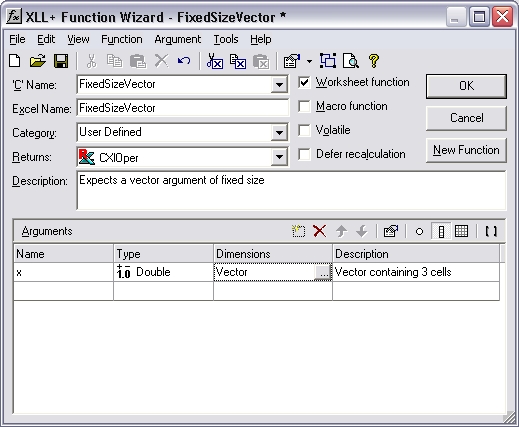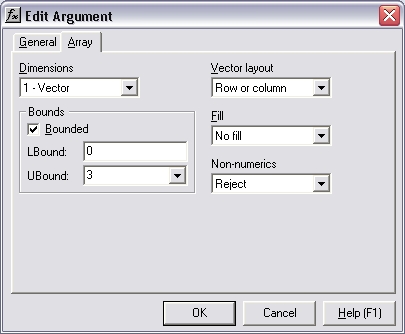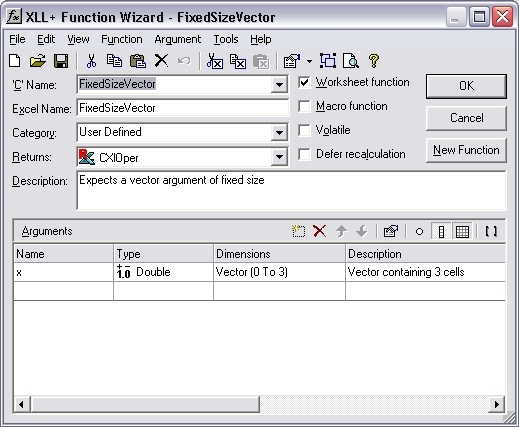HOW TO: How can I make sure that a vector or matrix input is of a fixed size?
Reference: Q0035
Article last modified on 30-Sep-2006
The information in this article applies to:
- XLL+ for Visual Studio 2005 - 5.0
- XLL+ for Visual Studio .NET - 4.2, 4.3.1, 5.0
- XLL+ for Visual Studio 6 - 3, 4.1, 4.2, 4.3.1, 5.0
HOW TO: How can I make sure that a vector or matrix input is of a fixed size?
Question
My add-in function expects an array of a particular size. Can I use the Function Wizard to specify this constraint?
Answer
You can modify your arguments to be bounded input arrays. The XLL+ Function Wizard has a tab which lets you set the bounds of an array, so that they are tied to a constant (or to a named variable). The code which is generated will automatically check that all matrix and vector inputs satisfy the constraints you apply.
If the input is not of the expected size, then an error value is returned, e.g.:
#Error: expected 5 items in x
Example
Problem: constrain a vector input to contain exactly 3 cells.
Steps
-
Create a new function,
FixedSizeVector(), using the XLL+ Function Wizard. It takes a single argumentx, which is defined as a vector of doubles.
-
Select the Dimensions column of the row containing the definition of
x, and click on the...button. (Or use the short-cut Ctrl+E.) This will display the Edit Argument dialog.Select the Array tab.
In the Bounds box, check the Bounded check-box and set the upper bound (UBound) to be 3, as shown below.

- Press OK to close the dialog.
-
Inspect the changes to the Function Wizard. The Dimensions column now contains the new definition of
x:Vector (0 to 3).
- Save the function.
Code
The code generated is shown below:
// Function: FixedSizeVector
// Purpose: Expects a vector argument of fixed size
//{{XLP_SRC(FixedSizeVector)
// NOTE - the FunctionWizard will add and remove mapping code here.
// DO NOT EDIT what you see in these blocks of generated code!
IMPLEMENT_XLLFN2(FixedSizeVector, "RP", "FixedSizeVector", "x",
"User Defined", "Expects a vector argument of fixed size",
"Vector containing 3 cells\000", "B0(0,3)x Vector containing "
"3 cells\0appscope=1\0", 1)
extern "C" __declspec( dllexport )
LPXLOPER FixedSizeVector(const COper* x)
{
XLL_FIX_STATE;
CXlOper xloResult;
BOOL bOk = TRUE;
std::vector<double> vecx;
long ubound_x = 3;
bOk = bOk && x->ReadVectorBounded(vecx, "x", xloResult, 0, ubound_x);
if (!bOk)
return xloResult.Ret();
//}}XLP_SRC
// TODO - Set the value of xloResult
return xloResult.Ret();
}
Explanation
The generated code has been changed from the normal pattern, as shown in bold above.
-
A new variable
ubound_xis generated, and is passed as an additional argument toCOper::ReadVectorBounded. - COper::ReadVectorBounded is called, instead of COper::ReadVector.
-
COper::ReadVectorBounded() checks that the size of the populated region of the
input
xmatchesubound_x, and returns FALSE if it does not. -
If COper::ReadVectorBounded() fails, the add-in function returns an error value
(which is placed in
xloResultby COper::ReadVectorBounded().
Result
If x does not contain 3 cells, the following error value is
returned:
#Error: expected 3 items in x
and the function does not continue.
See also
FAQ #0034 discusses various ways to use bounded input
arrays to constrain the bounds of an input.
Bounded input arrays - technical note in the online documentation.
Argument Dialog - Array Tab - tools help in the online documentation.
